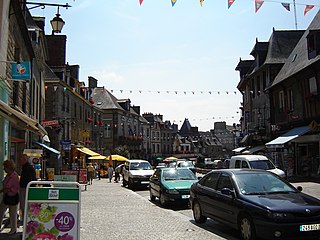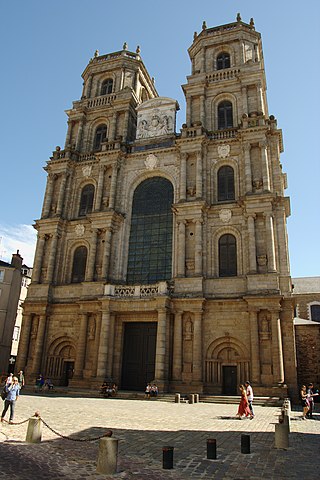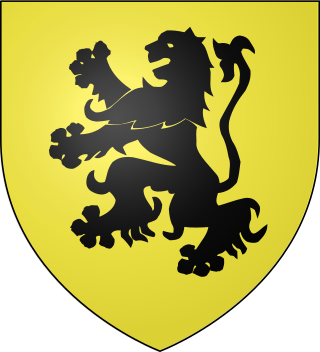
François-René, vicomte de Chateaubriand was a French writer, politician, diplomat and historian who influenced French literature of the nineteenth century. Descended from an old aristocratic family from Brittany, Chateaubriand was a royalist by political disposition. In an age when large numbers of intellectuals turned against the Church, he authored the Génie du christianisme in defense of the Catholic faith. His works include the autobiography Mémoires d'Outre-Tombe, published posthumously in 1849–1850.

Odo of Rennes, Count of Penthièvre, was the youngest of the three sons of Duke Geoffrey I of Brittany and Hawise of Normandy, daughter of Richard I of Normandy. Eudon married Agnes of Cornouaille, the daughter of Alan Canhiart, Count of Cornouaille and sister of Hoel II, Duke of Brittany who was married in 1066 to Eudon's niece Hawise, Duchess of Brittany.
Odo II, Count of Porhoet was the son of Geoffroy, Viscount de Porhoët, and his wife Hawise. He became Duke of Brittany in 1148, jure uxoris, upon his marriage to Bertha, Duchess of Brittany.

The House of Rohan is a Breton family of viscounts, later dukes and princes in the French nobility, coming from the locality of Rohan in Brittany. Their line descends from the viscounts of Porhoët and is said to trace back to the legendary Conan Meriadoc. Through the Porhoët family, the Rohans are related to the Dukes of Brittany, with whom the family intermingled again after its inception. During the Middle Ages, it was one of the most powerful families in the Duchy of Brittany. The Rohans developed ties with the French and English royal houses as well, and they played an important role in French and European history.

Dol-de-Bretagne, cited in most historical records under its Breton name of Dol, is a commune in the Ille-et-Vilaine département in Brittany in northwestern France.
Stephen of Penthièvre, Count of Tréguier, 3rd Lord of Richmond was a Breton noble and a younger son of Odo, Count of Penthièvre and Agnes of Cornouaille, sister of Hoël II, Duke of Brittany. In 1093, he succeeded to the title of Count of Tréguier; in 1098, he succeeded his brother Alain as Lord of Richmond in Yorkshire, England.

Auguste Marie Johanna of Baden-Baden, later Auguste Marie Jeanne, Duchess of Orléans, was a member of the ruling family of Baden-Baden who became Duchess of Orléans as the wife of Louis d'Orléans, Duke of Orléans. Her husband was a grandson of her father's former enemy, Louis XIV of France. Known in France as Auguste de Bade, she died in childbirth. She is an ancestor of Louis Philippe I and of several members of royal families of Europe, such as the Spanish and Italian royal families, as well as the present Grand Duke of Luxemburg.

The Archdiocese of Rennes, Dol, and Saint-Malo is a Latin Church diocese of the Catholic Church in France. The diocese is coextensive with the department of Ille et Vilaine. The Archdiocese has 8 suffragans: the Diocese of Angers, the Diocese of Laval, the Diocese of Le Mans, the Diocese of Luçon, the Diocese of Nantes, the Diocese of Quimper and Léon, the Diocese of Saint-Brieuc and Tréguier, and the Diocese of Vannes.
This is a list of those who bore the title Count of Soissons and ruled Soissons and its civitas or diocese as a county in the Middle Ages. The title continued in use into modern times, but without ties to the actual Soissonnais.

Emmanuel Félicité de Durfort, duc de Duras was a French politician, diplomat, peer, marshal and Freemason.
Isabelle de Craon, Dame de Fougères, was a French noblewoman, being the daughter of Amaury I, Sire de Craon, a wealthy baron who was the possessor of many lordships in Anjou and Maine. She was the wife of Raoul III, Sire de Fougères, by whom she had one daughter, Jeanne de Fougères, who became the heiress to her father's seigneury.
Louis of Lorraine was a member of a cadet branch of the House of Lorraine, the House of Guise and known as the Prince de Lambesc.

Louis of Lorraine was a member of the House of Guise, a cadet branch of the House of Lorraine. He married three times and through his daughter, is an ancestor of the present House of Savoy. He was the Grand Squire of France and Governor of Anjou.
Henri Chabot was a French nobleman and Duke of Rohan. His wife was the heiress Marguerite de Rohan, daughter of Henri, Duke of Rohan. He is also known as Henri de Chabot.
Rivallon I of Dol was the first lord of Combourg from before 1040. He was born to Hamo I, Viscount of Alet and Roianteline. Rivallon's eldest brother was Hamo II Viscount of Alet, while his next eldest brother Josselin became the seigneur of Diana. Another brother, Jungeon, became Archbishop of Dol. Rivallon also had a sister Imogen who was married to a knight of Alan III of Brittany -- a man she completely dominated, becoming the eventual guardian of their son Brien. Hamo I also had a natural son Saloman who was the given the fief of Garclip later known as the seigneurie of Du Guseclin.

Jean de Malestroit was a French pseudo-cardinal who served as Bishop of the Roman Catholic Diocese of Nantes from 17 July 1419 until 1443 AD when he resigned.

Herve I of Léon was the first Lord of Léon, the founding member of the junior branch of the Léon family.
Guihomar II de Léon was a Viscount of Léon. He is said to have succeeded his grandfather Guihomar I.

Andrew III of Vitré was Baron of Vitré and Aubigné from 1211 to 1250.












